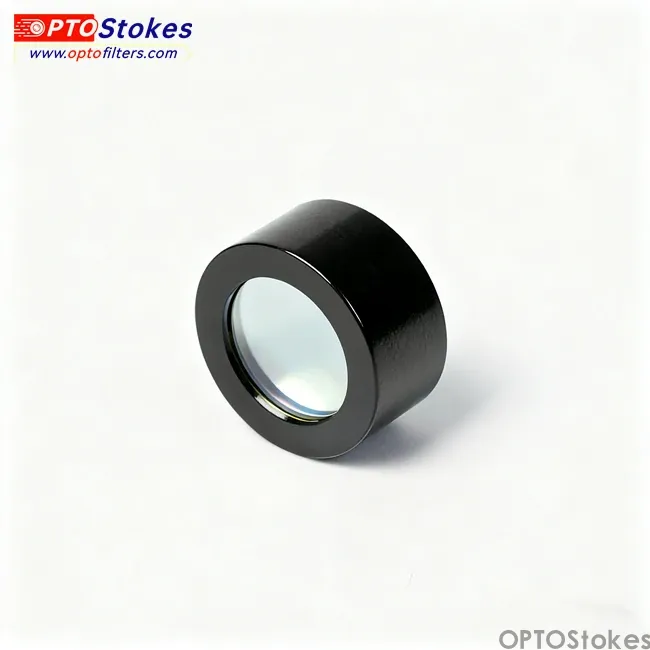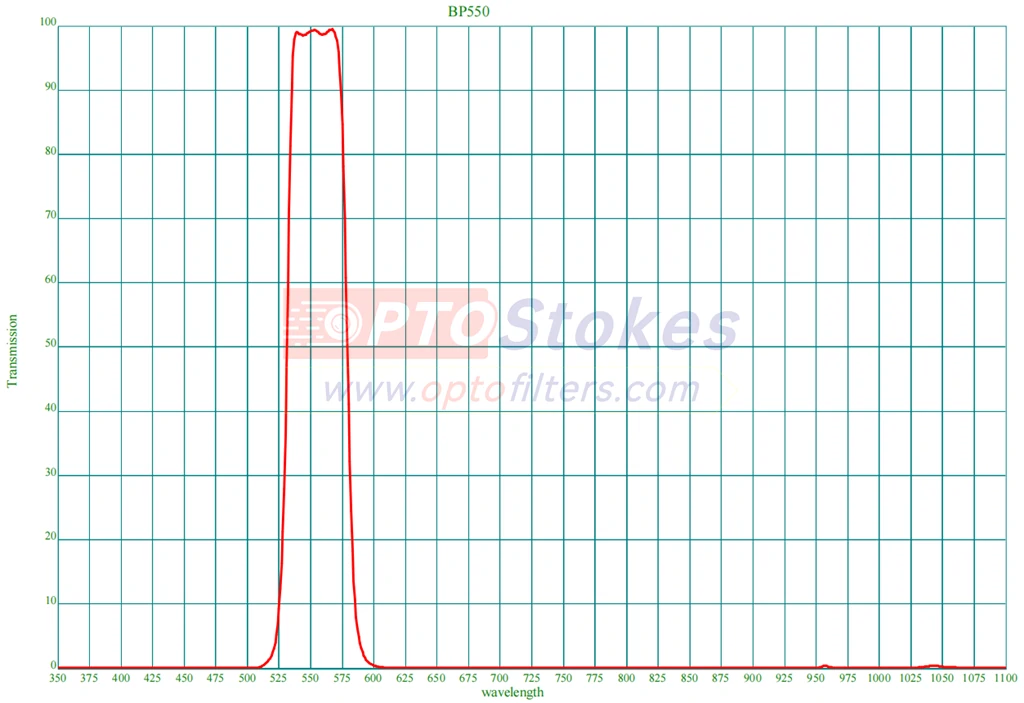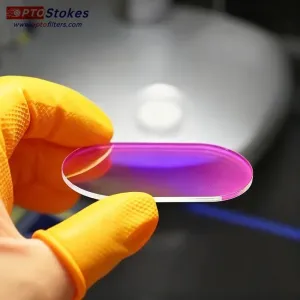BP560nm Bandpass Filter | FWHM 50nm, Thickness 1.1mm
The BP560-50nm-1.1mm bandpass filter is precision-engineered for applications demanding maximum light collection efficiency in the yellow-orange spectral region. Featuring a wide 50nm full width at half maximum (FWHM) centered at 560nm, this bandpass filter delivers exceptional photon throughput for fluorescence detection of Cy3, TRITC, rhodamine, and other commonly used orange-emitting fluorophores. With a broad transmission window spanning 555-570nm and comprehensive blocking from 400-1100nm at transmission less than 1%, this filter maximizes signal strength while maintaining effective spectral isolation. The optimized 1.1mm substrate thickness provides an ideal balance between compact integration and mechanical stability, making it suitable for diverse optical system architectures. Manufactured by OPTOStokes using advanced high precision coating technology, this filter delivers consistent performance for demanding research and industrial applications worldwide.
Technical Specifications
The BP560-50nm-1.1mm filter combines broad spectral bandwidth with effective out-of-band rejection, optimized for maximum signal collection in yellow-orange fluorescence applications. The following table details the complete technical specifications:
| Parameter | Specification |
|---|---|
| Center Wavelength (CWL) | 560nm ± 3nm at T greater than 90% |
| Transmission Range | 555-570nm at T greater than 90% |
| Full Width at Half Maximum (FWHM) | 50nm ± 5nm |
| Blocking Range | 400-1100nm at T less than 1% |
| Optical Density (OD) | Greater than 2.0 (equivalent to T less than 1%) |
| Substrate Thickness | 1.1mm |
| Surface Quality | 60/40 scratch-dig per MIL-PRF-13830B |
| Coating Type | Hard ion-assisted deposition |
| Part Number | 20207736 |
Key Performance Features
This 630nm filter region component demonstrates performance characteristics optimized for yellow-orange fluorescence applications requiring maximum signal collection. The wide 50nm FWHM provides substantially greater light gathering capability compared to narrow 10-20nm bandpass alternatives, making it ideal for photon-limited detection scenarios, high-speed imaging applications, and weak fluorescence measurements. Peak transmission exceeding 90% across the broad 555-570nm range ensures maximum photon throughput, critical for time-resolved measurements, high-frame-rate microscopy, and sensitive detection systems.
The wide passband efficiently captures the full emission spectrum of commonly used yellow-orange fluorophores. Cy3 dye with emission maximum at 570nm, TRITC (Tetramethylrhodopsin) with emission centered at 572nm, and rhodamine derivatives with emissions spanning 565-580nm all fall within or near the filter's high-transmission window. This broad spectral acceptance maximizes detected signal levels, improves signal-to-noise ratios, and reduces exposure times in fluorescence imaging applications. The wide bandwidth also provides tolerance for fluorophore emission variations caused by environmental factors including pH, temperature, and molecular interactions.
Despite the wide passband designed for maximum light collection, the filter maintains effective out-of-band blocking with transmission below 1% (optical density greater than 2) from 400-1100nm. This comprehensive rejection range suppresses green channel crosstalk from 515-545nm fluorophores, blocks excitation light from typical 530-555nm sources, and eliminates far-red and near-infrared interference from 600-1100nm. The deep blocking performance enables clean signal detection in multi-channel imaging systems and prevents detector saturation from intense excitation sources.
The optimized 1.1mm substrate thickness represents a unique design choice balancing compact integration with mechanical performance. This intermediate thickness provides greater rigidity than ultra-thin 1.0mm substrates while maintaining more compact dimensions than standard 2.0mm alternatives. The 1.1mm profile facilitates integration into space-constrained optical assemblies while ensuring adequate mechanical stability for secure mounting and long-term dimensional stability. This thickness also provides improved thermal dissipation compared to thinner substrates, beneficial for applications involving elevated operating temperatures or high optical power densities.
Applications
The BP560-50nm-1.1mm bandpass filter excels across diverse scientific and industrial applications where maximum yellow-orange light collection and compact integration are essential:
Widefield Fluorescence Microscopy: Traditional widefield microscopy systems prioritize imaging speed and large field of view, making wide bandpass filters ideal for efficient emission collection. The BP560 filter efficiently captures emissions from Cy3, TRITC, rhodamine B, rhodamine 6G, and Texas Red fluorophores commonly used in immunofluorescence, FISH (fluorescence in situ hybridization), and cellular localization studies. The wide bandwidth maximizes signal collection enabling shorter exposure times, reduced photobleaching, and improved viability in live-cell imaging. Biological research applications including tissue histology, developmental biology, and neuroscience benefit from the enhanced signal levels this fluorescence detection capability provides.
High-Throughput Screening and Drug Discovery: Automated microplate readers and high-content imaging systems used in pharmaceutical research require rapid, reliable fluorescence detection across 96, 384, or 1536-well formats. The BP560 filter enables efficient detection of rhodamine-based assays, Cy3-labeled compounds, and orange fluorescent protein reporters used in compound screening, cellular phenotyping, and dose-response studies. The wide bandwidth maximizes signal strength from each well, improving assay sensitivity and dynamic range. The compact 1.1mm thickness facilitates integration into multi-position filter wheels without excessive mechanical complexity.
Flow Cytometry and Cell Analysis: Flow cytometry systems analyze cells at rates of thousands per second, requiring efficient fluorescence collection at high particle velocities. The BP560 filter captures maximum emission from PE-Cy3, PE-Texas Red, and other tandem conjugates commonly used in immunophenotyping panels. The wide passband accommodates spectral variation between fluorophore lots and temperature-induced shifts during operation. Clinical diagnostic applications including immune cell enumeration, cancer detection, and infectious disease monitoring rely on this filter's high collection efficiency for accurate cell quantification and population discrimination.
Confocal Microscopy: Point-scanning confocal microscopy systems employ bandpass filters to collect fluorescence while rejecting laser scatter and adjacent fluorescence channels. The BP560 filter efficiently captures Cy3 and rhodamine emissions following 543nm HeNe laser or 561nm DPSS laser excitation. The wide bandwidth collects more of the fluorophore emission spectrum compared to narrow alternatives, improving signal levels in photon-limited deep tissue imaging and thick specimen applications. The blocking performance prevents green channel crosstalk and far-red channel bleed-through in multi-color confocal imaging.
Automated Imaging and Machine Vision: Industrial inspection systems and automated quality control platforms utilizing orange-yellow fluorescence for defect detection, surface inspection, and sorting applications benefit from this filter's high transmission and broad spectral acceptance. The wide bandwidth accommodates LED source variations and temperature-induced spectral shifts in production environments. Manufacturing applications including pharmaceutical inspection, food safety screening, and materials quality control rely on consistent filter performance for reproducible results.
Plate-Based Assays and Kinetic Measurements: Fluorescence plate readers monitoring enzyme kinetics, binding assays, and cellular responses in real-time require stable, efficient fluorescence detection. The BP560 filter enables accurate quantification of fluorogenic substrate reactions, protein-protein interactions, and cellular signaling events reported by orange fluorophores. The high transmission maximizes signal-to-noise ratios enabling detection of weak signals and small fluorescence changes during kinetic measurements.
Customization and Engineering Support
OPTOStokes recognizes that modern optical systems often require tailored solutions optimized for specific application requirements. Our engineering team collaborates with customers to develop customized filter designs meeting unique performance criteria:
Spectral Optimization: While the standard 50nm FWHM provides excellent light collection, bandwidth can be adjusted from 40nm to 70nm depending on application priorities. Narrower bandwidths improve spectral selectivity for multi-channel systems with closely spaced fluorophores, while wider bandwidths further maximize signal strength in photon-starved applications. Center wavelength can be tuned across the 555-565nm range to optimize alignment with specific fluorophore emission maxima or LED source characteristics. Custom passband shapes including flat-top profiles and asymmetric bandwidths can be engineered for specialized requirements.
Enhanced Blocking Specifications: For applications requiring deeper out-of-band rejection, we can design filters achieving optical density greater than 3 (transmission less than 0.1%) or optical density greater than 4 (transmission less than 0.01%) in critical spectral regions. Extended blocking ranges covering 350-1300nm accommodate applications with UV excitation sources or near-infrared detection systems. Specific blocking enhancement at excitation wavelengths or adjacent fluorescence channels can be implemented to minimize crosstalk and improve channel separation.
Dimensional and Thickness Options: Standard circular formats are available in diameters from 12.5mm to 50mm, with square, rectangular, and custom geometries manufactured to precise specifications. The 1.1mm thickness represents an optimized choice, but can be adjusted to 1.0mm for maximum compactness, 1.5mm for enhanced rigidity, or 2.0mm for applications requiring maximum mechanical stability and thermal mass. Precision edge finishing including beveling and black edge coating minimize scattered light in critical imaging applications.
Mounting and Integration Solutions: Filters can be supplied unmounted for adhesive bonding and direct integration, or pre-mounted in threaded retaining rings, drop-in cells, and filter cubes compatible with major microscope manufacturers. Custom mechanical interfaces accommodate legacy equipment and specialized instrumentation. Multi-filter assemblies combining this emission filter with complementary excitation filters and dichroic beamsplitters are available as integrated modules for simplified system assembly and guaranteed spectral compatibility.
Environmental Specifications: Applications in demanding environments benefit from enhanced durability specifications including extended temperature ranges from -40°C to +85°C, high humidity resistance up to 95% relative humidity, and vibration tolerance meeting MIL-STD-810 standards. Hard coating formulations ensure durability under repeated cleaning cycles, harsh chemicals, and high-intensity light exposure. UV-resistant materials prevent coating degradation in applications with UV light sources or outdoor deployment.
Why Choose OPTOStokes?
OPTOStokes has established industry leadership in optical filter manufacturing through continuous innovation, quality excellence, and customer-focused service. Our extensive inventory of standard bandpass filters ensures immediate availability for urgent requirements, with most configurations shipping within 24-48 hours of order confirmation. This rapid response capability eliminates project delays and accelerates instrument development timelines.
Our manufacturing expertise in wide bandpass filter design addresses the unique challenge of maintaining high transmission across broad spectral ranges while achieving effective out-of-band blocking. Advanced thin-film coating design software and ion-assisted deposition technology enable precise control of spectral characteristics, ensuring consistent performance across production batches. Every filter undergoes comprehensive spectral verification using calibrated spectrophotometers, with full transmission curves from 350-1200nm documented in detailed test reports.
Quality assurance encompasses all aspects of filter performance including spectral accuracy, surface quality, dimensional precision, and environmental durability. Automated inspection systems verify scratch-dig specifications per MIL-PRF-13830B standards. Precision metrology confirms thickness tolerances, diameter accuracy, and parallelism. Environmental testing validates coating adhesion, humidity resistance, and temperature stability according to industry standards and customer-specific requirements.
Our applications engineering team provides technical consultation throughout the product lifecycle, from initial filter selection through production integration and field support. We maintain comprehensive technical documentation including spectral data files, angular performance characteristics, temperature coefficients, and mechanical drawings to accelerate your development process. Long-term supply agreements ensure consistent filter availability and pricing stability for multi-year production programs.
Addressing Design Challenges
Optical system designers face specific considerations when implementing wide bandpass filters in fluorescence detection systems. Understanding these factors enables optimal filter selection and system performance:
Signal-to-Noise Optimization: In photon-limited applications, collecting maximum signal often takes precedence over ultimate spectral resolution. The BP560 filter's 50nm bandwidth collects substantially more photons than narrow 10-20nm alternatives, improving signal-to-noise ratios and enabling shorter integration times. For applications where signal strength is the primary limitation, this wider bandwidth delivers measurably improved detection sensitivity and imaging speed. Our applications team can model expected signal levels for specific fluorophores and recommend optimal bandwidth for your application.
Multi-Channel Spectral Separation: In multi-color fluorescence imaging, wider bandpass filters require careful fluorophore selection to prevent spectral overlap. The BP560 filter is designed for yellow-orange fluorophores in the 555-580nm emission range, providing adequate separation from green channels at 510-535nm and red channels at 590-620nm when properly configured. We provide spectral overlap modeling for customer-specified fluorophore combinations, predicting crosstalk levels and recommending optimal channel assignments and filter configurations.
Fluorophore Compatibility: Different fluorophores exhibit varying emission spectrum shapes and peak wavelengths. The BP560 filter's broad 555-570nm passband efficiently captures emissions from Cy3 (570nm peak), TRITC (572nm peak), rhodamine B (565nm peak), and Texas Red (615nm peak with significant emission extending into the 560-580nm range). We maintain a comprehensive fluorophore database and can provide compatibility analysis for specific dyes and fluorescent proteins used in your application.
Excitation Light Blocking: Yellow-orange fluorophore detection typically employs green-yellow excitation from 530-555nm sources. The BP560 filter provides optical density greater than 2 at typical excitation wavelengths, delivering 100-fold rejection sufficient for most fluorescence microscopy applications. For ultra-sensitive detection with intense excitation sources, enhanced blocking specifications can be implemented to prevent detector saturation and improve background suppression.
Compact System Integration: The 1.1mm thickness enables integration into compact filter wheels, motorized filter changers, and multi-position filter assemblies while maintaining adequate mechanical stability. This intermediate thickness provides design flexibility for systems where 1.0mm substrates lack sufficient rigidity but 2.0mm substrates exceed available axial space. Our mechanical engineering team provides integration consultation including tolerance stack-up analysis and mounting recommendations.
Quality Documentation and Compliance
Every BP560-50nm-1.1mm filter manufactured by OPTOStokes undergoes rigorous quality control testing to verify conformance with published specifications. Our ISO 9001:2015 certified quality management system maintains documented procedures for all manufacturing and inspection processes, ensuring consistency and full traceability.
Spectral performance verification includes transmission measurements across the full 350-1200nm range with 1nm resolution, documenting peak transmission, FWHM, center wavelength, passband edges, and blocking performance. Multiple measurements across the filter aperture verify coating uniformity. Surface quality inspection employs calibrated dark-field microscopy to verify scratch-dig specifications. Dimensional measurements confirm substrate thickness, diameter tolerances, and edge quality using precision metrology equipment.
Documentation packages include detailed spectral test reports with measured transmission curves, certificates of conformance, dimensional inspection results, and material certifications as required. Custom test protocols and enhanced inspection procedures can be implemented to meet specific customer requirements or regulatory compliance needs in medical device, pharmaceutical, or industrial applications. RoHS compliance certification and conflict mineral declarations are provided for customers requiring supply chain transparency and environmental compliance documentation.
Request Technical Consultation or Quotation
The BP560-50nm-1.1mm bandpass filter represents OPTOStokes' commitment to delivering practical optical solutions that address real-world application challenges. Whether your system requires maximum light collection efficiency, compact mechanical integration, or customized spectral characteristics, our team has the expertise and manufacturing capability to support your success.
Contact our technical sales team at sales@optofilters.com to discuss your specific requirements, request detailed technical specifications including complete spectral curves and angular performance data, or obtain pricing for prototype or production quantities. Our applications engineers can provide fluorophore compatibility analysis, spectral modeling, multi-channel filter set optimization, and system integration recommendations tailored to your unique application. For immediate access to comprehensive technical resources including spectral data files, mechanical drawings, and application notes, visit www.optofilters.com and explore our complete optical filter catalog.
We understand that successful optical instrument development requires more than high-quality components—it demands partnership with suppliers who understand your challenges and share your commitment to innovation and excellence. Experience the OPTOStokes difference: advanced optical filter technology, responsive technical support, and reliable delivery performance. Let us help transform your optical design challenges into competitive advantages with solutions engineered specifically for your success.








